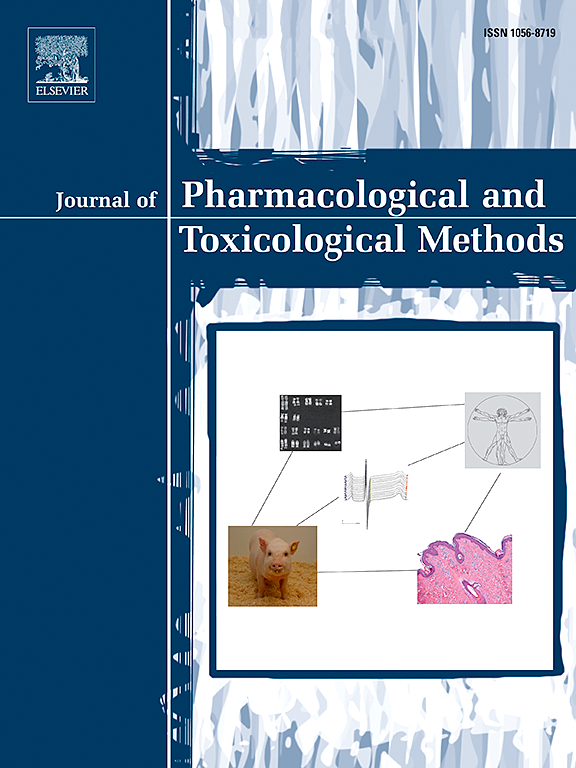Spatial regulation of CD14-like epitope in hematopoietic and ocular tissues of cultured North Atlantic lumpfish (Cyclopterus lumpus) and spotted wolffish (Anarhichas minor) during bacterial infection and temperature variations
IF 1.8
4区 医学
Q4 PHARMACOLOGY & PHARMACY
Journal of pharmacological and toxicological methods
Pub Date : 2025-07-16
DOI:10.1016/j.vascn.2025.108383
引用次数: 0
Abstract
The development of new tools for a better understanding of innate immune mediated responses to tissue damage in emerging model organisms could offer novel approaches to inform toxicology, disease mitigation and/or drug discovery. Innate immunity is one of the first lines of defence in response to tissue damage, with macrophages being key players in these processes. The expression of macrophage protein markers in North Atlantic marine teleost fish has not been extensively studied. Here we used an anti-mammalian-CD14 antibody to explore CD14 epitope expression in hematopoietic and ocular tissues of lumpfish and spotted wolffish. Western blotting indicated that proteins reactive with an anti-mammalian-CD14 antibody with similar molecular weights to mammalian CD14 isoforms exist in both lumpfish and spotted wolffish. Immunohistochemistry (IHC) analysis using this anti-mammalian-CD14 indicated CD14-like reactive epitope expression in head kidney and ocular choroid rete mirabile in both normal healthy lumpfish and in a Vibrio anguillarum marine bacterial pathogenesis paradigm. As infection proceeded in lumpfish, CD14-like expression increased in head kidney and ocular choroid rete mirabile vasculature as revealed by IHC. In addition, we also used a temperature challenge paradigm in spotted wolffish to assess CD14-like reactivity in ocular choroid rete mirabile. A six-week hypothermal condition led to higher levels of CD14-like expression in the wolffish choroid rete mirabile than control temperature or a six-week hyperthermal condition as revealed by IHC. The tissue spatial regulation of CD14 epitope in lumpfish and spotted wolffish we observed herein might serve as a tool in emerging novel model organism-based technologies toward a better understanding of the mechanisms involved in responses to tissue damage.
细菌感染和温度变化过程中培养北大西洋圆尾鱼和斑点狼造血和眼组织中cd14样表位的空间调控
为更好地理解新兴模式生物对组织损伤的先天免疫介导反应而开发的新工具可以为毒理学、疾病缓解和/或药物发现提供新方法。先天免疫是应对组织损伤的第一道防线之一,巨噬细胞在这些过程中起着关键作用。巨噬细胞蛋白标志物在北大西洋海洋硬骨鱼中的表达尚未得到广泛研究。本研究使用抗哺乳动物CD14抗体检测了CD14表位在肿块鱼和斑点狼造血和眼组织中的表达。Western blotting结果表明,肿块鱼和斑点狼体内均存在与哺乳动物CD14亚型分子质量相似的抗哺乳动物CD14抗体反应的蛋白。使用这种抗哺乳动物cd14的免疫组织化学(IHC)分析表明,在正常健康的肿块鱼和鳗弧菌海洋细菌发病模式中,头肾和眼脉络膜中cd14样反应性表位的表达都是不可逆转的。免疫组化显示,随着肿块鱼感染的进行,cd14样表达在头肾和眼脉络膜血管中增加。此外,我们还使用了斑点狼的温度挑战模式来评估cd14样蛋白在眼脉络膜细胞中的反应性。免疫组化结果显示,6周的低温条件导致狼脉络膜中cd14样表达水平显著高于对照组或6周的高温条件。我们在此观察到的肿块鱼和斑点狼的CD14表位的组织空间调控可能作为新兴的基于模式生物的新技术的工具,以更好地理解组织损伤反应的机制。
本文章由计算机程序翻译,如有差异,请以英文原文为准。
求助全文
约1分钟内获得全文
求助全文
来源期刊

Journal of pharmacological and toxicological methods
PHARMACOLOGY & PHARMACY-TOXICOLOGY
CiteScore
3.60
自引率
10.50%
发文量
56
审稿时长
26 days
期刊介绍:
Journal of Pharmacological and Toxicological Methods publishes original articles on current methods of investigation used in pharmacology and toxicology. Pharmacology and toxicology are defined in the broadest sense, referring to actions of drugs and chemicals on all living systems. With its international editorial board and noted contributors, Journal of Pharmacological and Toxicological Methods is the leading journal devoted exclusively to experimental procedures used by pharmacologists and toxicologists.
 求助内容:
求助内容: 应助结果提醒方式:
应助结果提醒方式:


